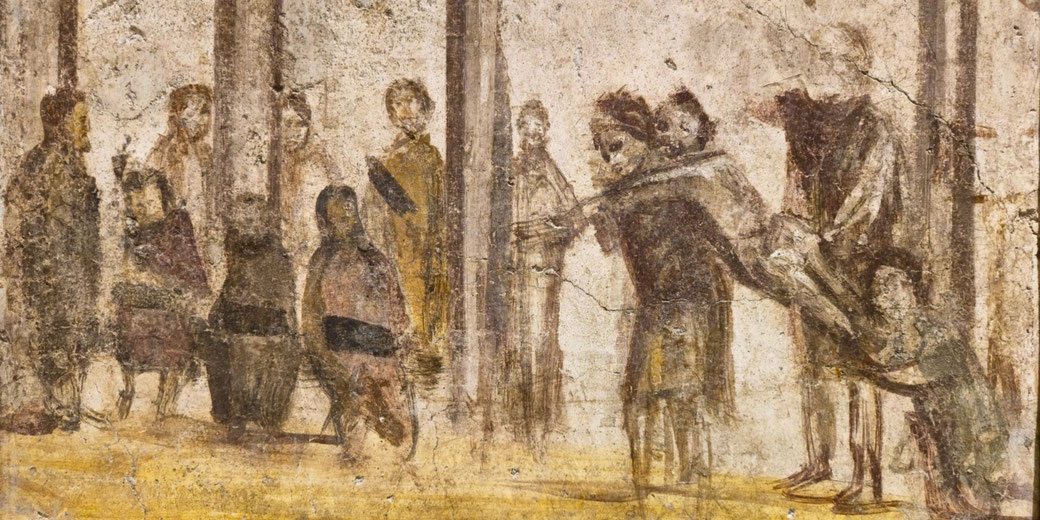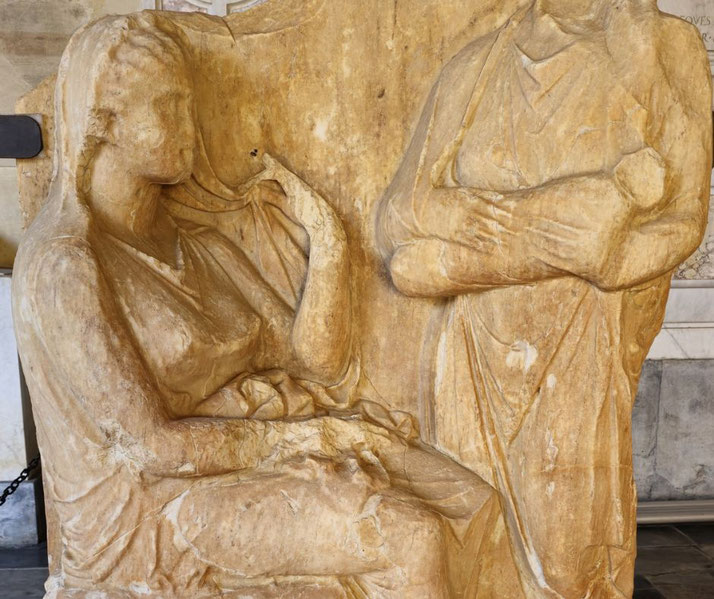What was childhood like in Ancient Rome?

In the heart of the greatest empire of the ancient world, amidst the grandeur of the Colosseum and the bustling Roman Forum, a different world thrived - the world of Roman children.
This often-overlooked aspect of Roman society was a microcosm of the empire itself, reflecting its values, hierarchies, and complexities.
But what was it like to be a child in ancient Rome?
What games did they play, and what roles did religion and superstition play in their lives?
How did their social status affect their experiences?
And how did they navigate the transition from childhood to adulthood?
The deadly reality of being born in ancient Rome
The journey of a Roman child began even before birth, with various rituals and superstitions surrounding pregnancy and childbirth.
Expectant mothers in ancient Rome were both revered and carefully protected, as childbirth was a dangerous endeavor, fraught with risks.
The high infant mortality rate was a grim reality of the time, with many children not surviving past their first year.
This harsh fact of life was reflected in the delay of official naming ceremonies until the infant had survived the precarious first few days.
The birth of a child was a significant event in a Roman household. The process was overseen by a midwife, or 'obstetrix', an important figure who provided care and support to the mother.
Following the birth, the newborn was placed on the ground and only picked up by the father if he chose to acknowledge and accept the child into the family, a ritual known as 'tollere'.
This act symbolized the patriarch's acceptance of the responsibility for raising the child.
Infancy in ancient Rome was a period of intense care and vulnerability. Swaddling was a common practice, believed to help the baby grow strong and straight.
Wet-nursing was also prevalent, particularly among the wealthier families. In some cases, slaves or servants were employed to nurse and care for the child, highlighting the class differences that were ingrained in Roman society from the earliest stages of life.

How did a child get their name?
The naming of a child in ancient Rome was not just a matter of personal preference, but a significant event steeped in tradition and social implications.
The ceremony of naming, known as 'dies lustricus', was held on the ninth day for boys and the eighth day for girls after birth.
This delay was due to the high infant mortality rate, and the ceremony itself was seen as a celebration of the child's survival.
Roman names were deeply symbolic and often indicated the child's place within the family and society.
Boys typically received three names or 'tria nomina': a personal name (praenomen), a family name (nomen), and a name indicating their broader clan or tribe (cognomen).
Girls, on the other hand, were usually given a feminine form of their father's nomen, and if there were multiple daughters, they were often distinguished by numerical terms like 'Prima', 'Secunda', 'Tertia', and so on.
The social status of a child was largely determined by their birth, and this was reflected in their names.
The children of the patrician class, the highest social order, often had a wide range of names to choose from, while the plebeians, the common people, had a more limited selection.
Slaves, who were considered property rather than citizens, did not have the privilege of the 'tria nomina' and were given only a single name by their masters.
What was family life like?
Family life in ancient Rome was a complex interplay of roles and responsibilities, deeply influenced by social status and tradition.
At the heart of the Roman family, or 'familia', was the 'paterfamilias', the male head of the household.
He held absolute authority over the family, including the power of life and death over his children.
Despite this seemingly harsh structure, evidence suggests that many Roman fathers were affectionate and caring towards their children.
The role of the mother in the Roman family was primarily centered around the home.
She was responsible for managing the household, raising the children, and overseeing the education of the daughters.
While her role was largely domestic, the Roman matron was a figure of respect and influence within the family.
Siblings played a significant role in a Roman child's life. Older siblings, particularly brothers, were often involved in the upbringing of their younger siblings.
This was especially true in the case of early death of a parent, a common occurrence given the life expectancy in ancient Rome.
The role of slaves in the Roman family was significant, particularly in wealthier households.
They performed a variety of tasks, from domestic chores to tutoring the children. In some cases, slaves were a constant presence in a Roman child's life, acting as caregivers and companions.
Despite the formal structure and strict roles, Roman families were not devoid of warmth and affection.
Children were cherished and their achievements celebrated. Family meals, religious festivals, and public games were occasions for family bonding and joy.
Did Roman children go to school?
Early education in Roman society was primarily the responsibility of the parents, particularly the mother.
In the initial years, children were taught at home, learning the basics of reading, writing, and arithmetic, as well as moral lessons from mythology and history.
The emphasis was on practical knowledge and skills that would prepare them for their roles as adults.
As the child grew older, formal education became more structured and rigorous. Wealthy families often employed private tutors or sent their children to small private schools, known as 'ludus'.
These schools, run by a 'ludi magister', provided instruction in more advanced subjects such as grammar, rhetoric, and sometimes even philosophy and music. However, education was not universally accessible.
While boys from all social classes had some access to education, girls' education was often limited to domestic skills, and slaves were generally not educated at all.
An interesting aspect of Roman education was the role of slaves. Educated slaves, known as 'paedagogus', were often employed by wealthy families to tutor their children.
These slaves were highly valued and played a significant role in the intellectual development of their young charges.

Why Roman children were forced to go to work
In the context of ancient Rome, the concept of childhood was significantly different from our modern understanding.
Children were often seen as small adults, and it was common for them to start contributing to the family's income from a young age.
This was particularly true among the lower classes, where economic necessity often overrode the luxury of a prolonged childhood.
Child labor in ancient Rome was not universally perceived as exploitative or detrimental to the child's development.
Instead, it was seen as a necessary part of growing up, a way for children to learn practical skills and contribute to the family's livelihood.
The type of work a child was engaged in largely depended on their family's social status and occupation.
Children of farmers would assist in the fields, while those from artisan families might help in the family's workshop.
Apprenticeship was a common practice, particularly in the trades. A young boy might be sent to learn a trade from a master craftsman, living with him and learning the skills of the trade over several years.
This was not just a process of skill acquisition, but also a form of socialization, where the apprentice learned the norms and values of the trade community.
For girls, their work was primarily centered around the home. From a young age, they were taught domestic skills such as cooking, weaving, and managing a household.
These skills were seen as essential for their future roles as wives and mothers.
What did Roman children do for fun?
Despite the rigors of education and the early onset of work responsibilities, children in ancient Rome also had time for leisure and games.
These activities were not just a source of amusement, but also an important aspect of a child's social and physical development.
The games played by Roman children were often reflective of adult activities, serving as a form of play-based learning.
Boys played with miniature weapons and chariots, emulating the gladiators and charioteers they admired.
Girls, on the other hand, played with dolls, often intricately crafted with movable limbs and dressed in miniature togas, mirroring their future roles as wives and mothers.
Board games were popular among children of all social classes. 'Ludus latrunculorum', a game similar to chess or checkers, was a common pastime. 'Tabula', a precursor to backgammon, was also widely played.
These games were not just entertaining, but also helped children develop strategic thinking and problem-solving skills.
Outdoor games and physical activities were encouraged for their health benefits. Children played ball games, went swimming, and engaged in mock battles.
These activities promoted physical fitness, a valued trait in Roman society, particularly for boys who were expected to serve in the military.
Festivals and holidays were occasions for special games and performances. During the 'Saturnalia', a festival in December, societal norms were temporarily overturned, and children were allowed to gamble, a privilege usually reserved for adults.
How and when did children become adults?
The transition from childhood to adulthood in ancient Rome was marked by significant rituals and ceremonies, symbolizing the child's new status and responsibilities.
This process, however, was not the same for all children. It varied based on gender, social class, and family traditions.
For boys, the most significant rite of passage was the 'toga virilis' ceremony, also known as the 'toga of manhood' ceremony.
This usually took place around the age of 16, but could vary depending on the family's decision.
During this ceremony, the boy would discard the 'toga praetexta', a toga with a purple border worn by children, and don the plain 'toga virilis', signifying his entry into manhood.
This was often followed by a public ceremony and a family feast. After this point, the young man was eligible for military service and could participate in public affairs.
For girls, the transition to womanhood was marked by marriage rather than a specific ceremony.
Roman girls were often betrothed in their early teens and married soon after, usually to much older men.
The wedding ceremony, with its rituals of dowry, procession, and the carrying of the bride over the threshold, marked the girl's entry into adulthood and her new role as a wife.
Coming of age was a significant milestone in a Roman child's life, marking the end of childhood and the beginning of adult responsibilities.
It was a period of change and growth, filled with both excitement and apprehension.
What do you need help with?
Download ready-to-use digital learning resources
Copyright © History Skills 2014-2025.
Contact via email
With the exception of links to external sites, some historical sources and extracts from specific publications, all content on this website is copyrighted by History Skills. This content may not be copied, republished or redistributed without written permission from the website creator. Please use the Contact page to obtain relevant permission.





